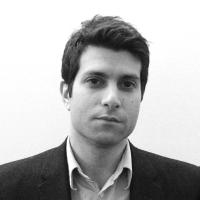Rioters in Iraq’s capital set fire to buildings in a Sunni neighborhood late Wednesday night, threatening to erupt in sectarian violence before Iraqi security forces restored order in the area.
No deaths or injuries have yet been confirmed in the violence, but images from the scene show widespread damage. And as the Sunni district of Adhamiya smolders, it has awakened some of the nightmare scenarios of Iraq plunging into civil war.
After the militant Sunni group ISIS captured the northern city of Mosul last June and began expanding its insurgent fiefdom in Iraq, there were two widespread fears. One was that Baghdad would fall to the jihadist army; the other was that ISIS’s brutality toward the country’s Shia majority would trigger reprisal attacks that would plunge the country into civil war. Neither of those scenarios has come to pass. But as the war against ISIS drags on and sectarians on both sides try to consolidate their power, the chance of incidents like Adhamiya sparking a wider conflagration remains.
The destruction in Adhamiya came a day after a car bomb in central Baghdad killed 19 Shia pilgrims. That attack, like the recurring explosions inside Baghdad targeting Shia, was linked to ISIS.
By Thursday local media reported that at least 15 arrests had been made. That morning Iraq’s prime minister, Haider al-Abadi, released a statement in Arabic blaming the violence on “terrorists” and vowing to prosecute those responsible before visiting the area to survey the damage. During his visit Abadi reportedly described the perpetrators of the violence as “no different from ISIS terrorist organization.”
The violence was also condemned by Shia religious figures including the influential cleric Moqtada al-Sadr.
No mention was made in the government statements about whether the Shia militias aligned with the government played any role in the rioting. The power of the militias, some of which are backed by Iran’s government, has risen sharply in the last year as they have taken on a leading role in securing the capital and fighting ISIS. At the same time, the militias have looted some areas under their control and been accused of war crimes.
Nevertheless, one Sunni resident of Adhamiya told The Daily Beast that the arsonists were members of two influential Shia militias, Asaib Ahl al-Haq and the Badr Organization, both backed by Iran’s elite Revolutionary Guards Corps-Quds Force and implicated in a host of anti-Sunni atrocities by Amnesty International and Human Rights Watch.
“They attacked us while we slept. From 3 to 7 in the morning, they came armed with guns, chanting anti-Sunni slogans and telling us to leave Baghdad,” said the resident, who asked to be called Sara to conceal her real name. “Then Prime Minister [Haider] Abadi arrived four hours later. But by then, 50 houses had been burned down and I don’t know how many cars.” Sara’s own home was spared, she said. The Daily Beast could not independently confirm the damage, although social media has been awash with images and videos purporting to show the rioting and aftermath of charred infrastructure.
During this latest round of sectarian violence, one of the buildings set alight belonged to the Sunni Waqf, or Endowment, although the main complex of that organization was left unscathed.
Adhamiya, the Sunni neighborhood targeted by the rioters, is connected by bridges to the majority Shia area of Kadhimiya, Adhamiya’s sister city, which sits on the west side of the Tigris River. The crowds in Adhamiya on Wednesday night were made up of Shia pilgrims passing through the neighborhood on their way to visit a shrine in Kadhimiya. One of the causeways connecting the two cities, the Aimmah Bridge, was the site of one of Iraq’s deadliest events in August 2005, when more than a thousand people were trampled and crushed to death after panic erupted on the bridge following the threat of a suicide bombing.
Still, it’s not unusual for Shia to walk the same route and is not in itself seen as any kind of sectarian incitement. As one Sunni resident of Baghdad, who asked to be called Tony to conceal his real name, explained to The Daily Beast, “It’s normal for the Shia pilgrims to cross through the main road in Adhamiya.”
It’s not clear what initially triggered the violence Wednesday night, whether it was started spontaneously by the pilgrims themselves or instigated by militia groups seeking to exact punishment on Baghdad’s Sunnis. The situation, already volatile, seems to have been inflamed further when someone in the group of Shia pilgrims falsely warned of a suicide bomber in the crowd.
Once the violence began, it burned through Adhamiya. Crowds cheered on the destruction, stepping back only to capture the act on video and film. One “selfie” circulating on social media appears to show a member of the Iraq’s security forces posing to memorialize his part in the destruction.
“Adhamiya is close to Sadr City and two Sadrist neighborhoods of Shaab and Ur on the northeast side of Baghdad,” a U.S. military intelligence officer who specializes in Iraq told The Daily Beast. “During the U.S. war in Iraq, jihadists from al Qaeda in Iraq [ISIS’s predecessor] would come out of Adhamiya with car bombs into Sadr City. As that was happening, the [Shia] Mahdi Army committed sectarian ethnic cleansing in Adhamiya. Some of the buildings in the Abu Hanifa Mosque complex were being used as insurgent headquarters.” (Abu Hanifa is the most important Sunni mosque in Iraq, named for the founder of the Hanifi school of Islamic jurisprudence, which is one of four such schools in Sunni Islam.)
“Whichever militia or militias did the riots, I’m pretty sure they originated in Sadr City,” the intelligence officer said.
Calm seems to have returned to Adhamiya, at least temporarily. But sectarian tensions in Baghdad are never far from the surface.
Reporting from Baghdad last summer, one of the authors of this article visited a prominent Shia cleric turned military recruiter. He insisted during an interview that the men he was sending off to fight ISIS were not militia but part of the military, but doubts grew, especially after one of his recruits showed off a video of himself and his friends torturing a man they said was an ISIS captive.
The Daily Beast reported in August:
The memory of Iraq’s last civil war, when sectarian death squads and terrorist cells defined victory through slaughter, is less than a decade old. It’s recent enough that it provides consolation for Baghdadis who point out that it’s not that bad yet, but also it’s a grim foreshadowing of what might come next.
One member of the Mahdi militia who supported the military’s fight against ISIS but had not made any allegiance to the government told me, “I only want to protect my family and the Shia holy places from ISIS.” He didn’t want a civil war, he said, or to pursue vengeance. “But if this goes on I can’t say what my neighbors will do. They might begin to just kill Sunnis.”
“This is nothing like 2006,” my Sunni driver said and waved towards Baghdad lit at night outside our car’s window. This was on July 16, after a car bomb exploded in Sadr City, killing at least nine people and wounding dozens.
“Back then there were no lights, only from bullets and fires. You couldn’t leave your house at night. If you weren’t killed you would be kidnapped or arrested.” He’d been arrested once in 2006. He was taken off the street by the Iraqi army and held in an American prison until the military police unit holding him realized there was nothing to charge him with and let him go.
Today the same driver who said last summer that Baghdad was nothing like the worst days of the country’s civil war says: “It’s difficult on the Sunnis now, and it’s getting worse day by day. It’s from the militias.”






